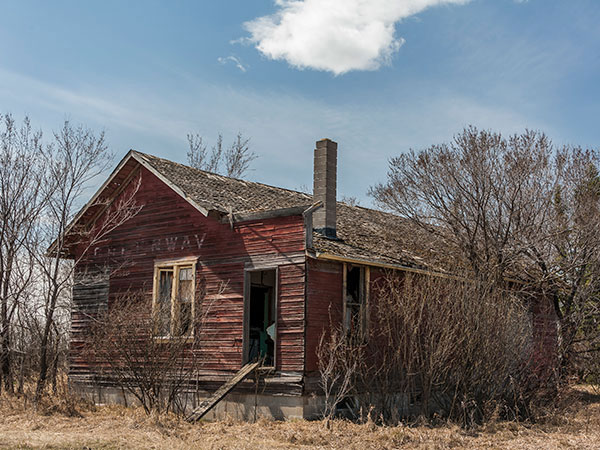|
Greenway
| Glenora | Neelin | Louise
Siding | Holmfield
| Enterprise | Lena | Anderson's
Siding
| Wakopa
Greenway
 Greenway was a railway town. Had the Northern Pacific Railway had its way Greenway would have been its only stop as it passed westward through Argyle. Named after no less a person than the Premier himself who had pioneered in the Crystal City area to the south, it would logically have been an important commercial centre. The creation of Baldur, not part of the original plan, meant that Greenway would never grow beyond its small hamlet status. The towns were just too close together. Before its appearance, locals would have got their mail at the W. Craik residence, the address being Dry River. If you lived in the eastern part of that district you might go to Mariapolis for mail and supplies. But as of 1889 the railway company had determined that Greenway was the place. 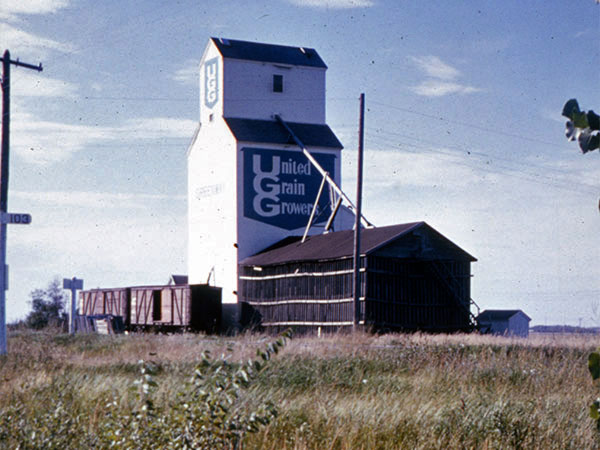 Historic Sites of Manitoba The
town site may never have grown beyond the 3-street – three avenue grid
that was originally surveyed, but it quickly developed the basic
commercial, educational, recreational and spiritual facilities that
would carry it through most of a century. For a short time its
inhabitants might have hoped for more, especially around 1903 when the
Wakopa Subdivision, which created the new towns of Glenora, Neelin,
Holmfield, Lena and Wakopa, made Greenway somewhat of a transportation
hub. But there was just no need for more people or more services and
Greenway remained on of those tiny villages whose importance and far
outstripped its modest size.
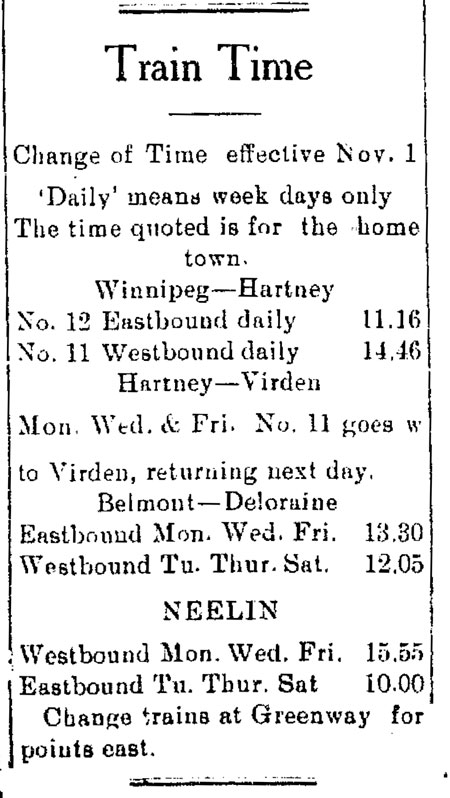 Baldur Gazette April 27, 1916, A Standard Fourth Class CN stationhouse was built in 1910 at Greenway, and was extended in 1918. It was moved to a site north of the village and used as a residence. Only nine examples of this design were constructed in Manitoba and this one is believed to be the only survivor. White lettering of the town name was still intact on its sides in 2019. 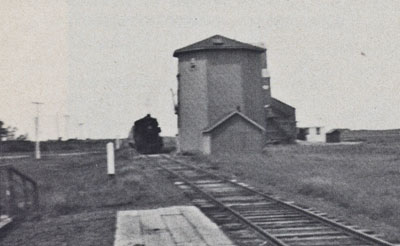 The last passenger train to stop at Greenway. 1959. .(Argyle History) CNR Employees As Greenway was a railway town the agents and section men who worked in the station and on the track are worthy of mention. Agents James Flack, Mr. Whiteside Mr. Clarksin, Mr. Brunsdin, Charles Cranston, Roy Phelps, Philip Arnaud, Earl Helgason, Robert Tully, Wm. Gillespie. Robert Coutts, Ron Denker, Les Widdifield, Elgin Cramer Section Crews Robert Bradley, Dan Roy, Joseph Smith (foreman). Frank Smith, Geo. Standbridge (foreman), Alfred Marshall, Geo. Stoner (foreman), James Wright, Eli Desrochers. Randy Fuglsang (foreman),Tom Vickers, Wm. Vickers, Fred Jordan Elevator Operators Greenway agents remembered are: Thomas L. Lawrence for Northern Elevator Co.; Wm. B. Cornock and Charlie Smith for Dominion Elevator Co.; Andrew Vickers, Mason Hedley, Rendal Hedley and Charlie Destoop for United Grain Growers. \
 Roy Phelps, R.R. agent at Greenway in 1912. Stockyards The stockyards were north of the tracks and had cattle, horses and pigs corralled there at least one day each week for several years. Buyers Bill Bray, Baldur; Joe Webber Sr.; Elwood Baird, Pilot Mound; Carson Bros., Cypress River and Harry Strang. They would scout the country to buy cattle which were brought to the stockyards early on Tuesday mornings. The Wakopa, with some cattle cars loaded in Neelin and Glenora, would meet a freight train in Greenway where the stock there was taken aboard and headed for Winnipeg packing companies. The cheques for these animals would be out to the farmers in Friday's mail. George Playfair ordered a carload of broncos, which were unloaded in Greenway stockyards. Duffer and Mr. Leifman had bush horses shipped to Greenway stockyards in the spring where local farmers would pasture and work them for the summer. In 1903, the Canadian Northern built the Wakopa Subdivision, known locally as simply the Wakopa Line, which left the main line at Greenway and angled southwest toward Wakopa, an early settlement south of Boissevain. The rails were laid to Wakopa by 1906. 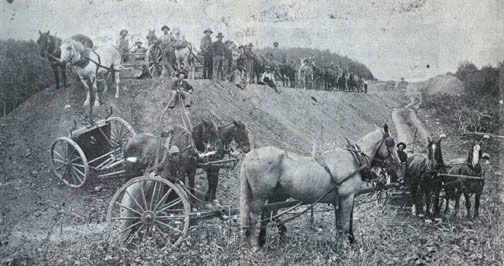 Grading the Wakopa Line, near Greenway. (Argyle History) For more about Greenway ... http://www.virtualmanitoba.com/Places/G/greenway.html
|

